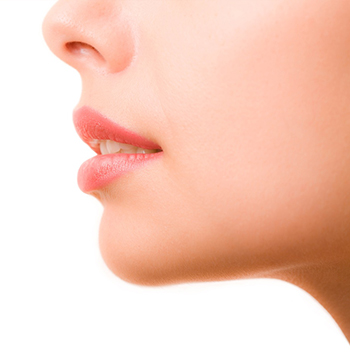Chin and Cheek Implants
Contoured Facial Implants
Facial beauty is the combination of facial features, proportion, and harmony. When the balance is pleasing, the face is attractive. When features are out of proportion, the eye tends to consider them unattractive. Well-defined, balanced facial features and facial contours are considered a sign of beauty. Facial implants can achieve these goals.
People seek correction for facial features such as a weak chin, flat cheekbones, round face, a narrow jaw line or pointed chin. It is important to correctly analyse the magnitude of the nasal profile, the size and shape of the cheekbones, or angularity of the jaw line for the overall impact they exert on facial beauty. For example, a stronger nose will accentuate a weak chin. Small cheekbones make the nose appear larger, and a square jaw line diminishes the significance of the upper part of the face.
Facial implants are contoured to fit onto the natural bone structure. Different size implants are available and made from various materials. They may extend over smaller or larger areas with different thicknesses to create varying projections, thus enhancing either a portion or the entire cheek or jaw line. Modern implants can be used to improve features in any age group, or in combination with other rejuvenation procedures.
Safety?
Facial implants are made of solid silicone elastomer. This is the most common biomaterial used for implantation, and has been used safely for over 60 years in almost every field of medicine and surgery. Silicone elastomer is NOT the same material that is used in gel-filled breast implants. Another material commonly used is ePTFE or Goretex®. There are now textured ePTFE-coated silicone "composite" implants, which combine the advantages of both materials. It is extremely rare for any of these materials to produce tissue reactions or be rejected by the body.
Chin Implants, Mandibular Implants, and Mandibular Angle Implants.
Many people have a small chin - one that recedes or is not prominent enough. A small chin can make a person's nose appear more prominent or create the illusion that the neck is poorly defined, whereas a chin that is more in harmony with other facial features can give the entire profile a more pleasing balance.
Mandibular implants provide a more natural look from both the front and side views. Chin implants create a subtle projection to a small, recessive chin. Chin implants can be used in people who undergo Rhinoplasty. Dr Imani considers your overall profile before performing either one of the procedures. Placement of a chin implant will restore the balance between the nose and the chin, ensuring that the nose will be a better fit for the face.
When performed in conjunction with a facelift, augmenting a small chin can also dramatically improve the configuration of the jaw-neck line to effectively reduce the "double chin." Mandibular augmentation is also easily combined with removal of fat (via liposuction) from under the chin, which further improves the overall affect of mandibular augmentation.
Narrow jaws can also be enhanced with the use of "mandibular angle" implants. These implants are placed through incisions along the gum line at the back of the mouth. These implants are considered to be extremely powerful in effecting dramatic changes in the shape of the jaw and entire lower third of the face.
Are there risks involved?
Yes. There are risks involved in all medical procedures. Dr Imani will gladly discuss and disclose all possible risks, benefits and alternatives involved at the time of consultation. Our practice staff will provide you with written procedure specific information sheets after your consultation.

Anaesthesia:
Local anaesthetic with sedation, or general anaesthesia.
In/Outpatient:
Inpatient short stay or outpatient/same day.
Length of Surgery:
1-2 hours.
Pain Score:
Minimal pain, relieved with simple pain killers. The application of cold compresses is extremely comforting after surgery and they should be applied regularly in the first few days after surgery to minimise bruising and swelling. You will feel a pressure sensation around the implanted area. This settles in a few days time.
Dressing:
A light cotton dressing is applied for 24 hours. You may have small skin coloured tapes placed on the operated area.
Recovery and getting back to work:
Some swelling (but rarely any bruising) can be expected. The major swelling is gone within two weeks and the fine definition and final form of new facial contours gradually emerge after 4-6 weeks.
Back to work: 5 days-1 week.
Normal social, recreational, travel activities: 1-2 weeks.
More strenuous activities: 2-3 weeks.
Any surgical or invasive procedure carries risks. Before proceeding, you should seek a second opinion from an appropriately qualified surgeon.
Got a Question?
Thank you for your enquiry!
We will be in contact with you soon.


